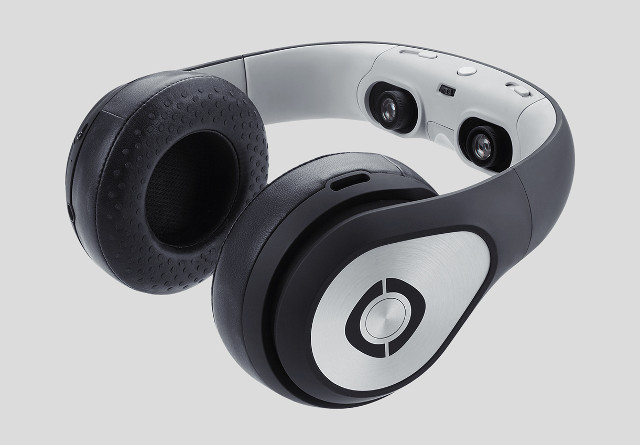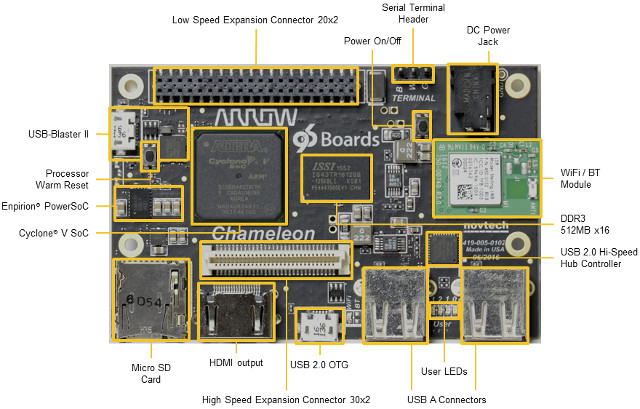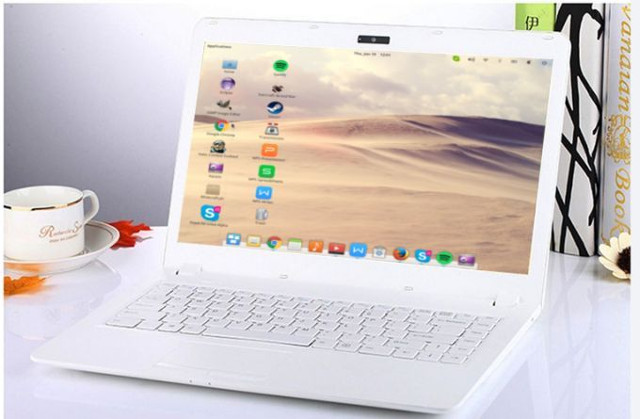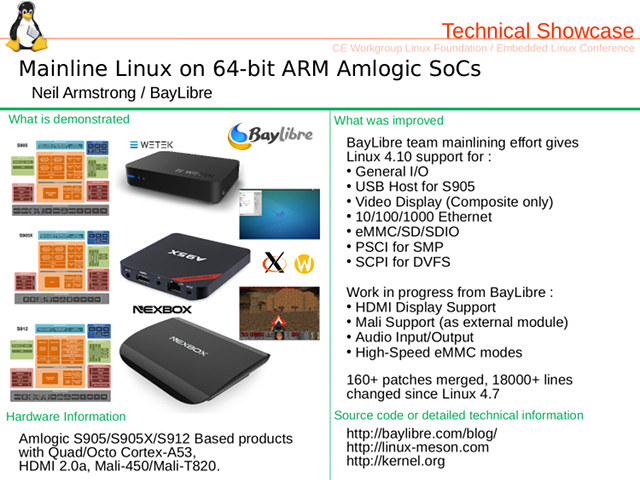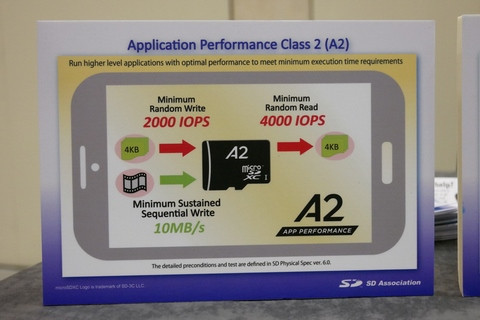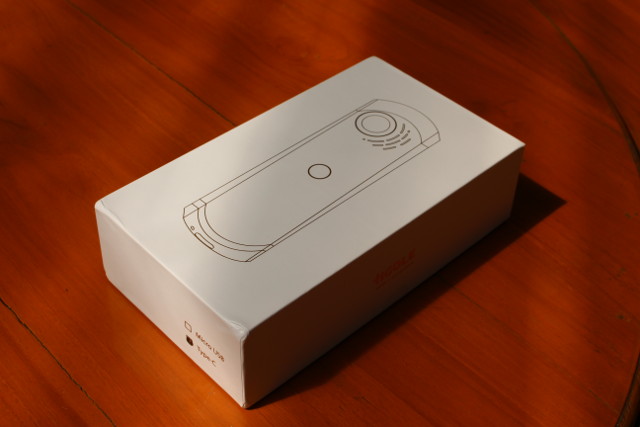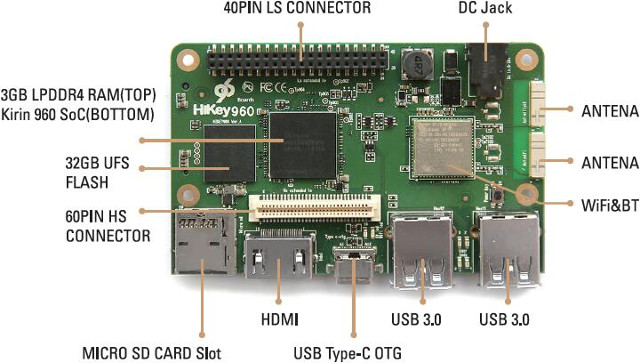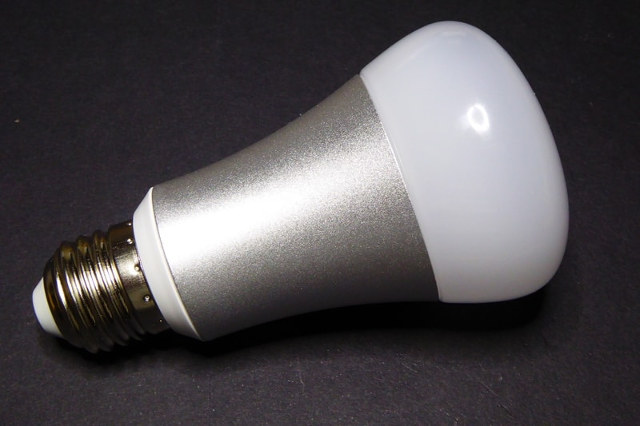I reviewed my first and only Android VR headset last year, and while it was fun to use for short periods, I found it very uncomfortable to my eyes and head for periods of usage over 15 minutes, and would definitely not watch an entire movie on such device. Avegant’s engineers worked for a headset for the military that had to be used for long periods of time, and they found they could adapt their product for consumer use and create Avegant Glyph, and alternative to VR headset that looks like a stereo headset, but also includes two 720p DLP projectors placed right in front of your eyes, hereby creating your own private, and portable – home theater. Avegant Glyph specifications: Resolution – 1280x720p per eye via 2 million micro-mirrors Aspect Ratio – 16:9 Field of view – ~40° diagonal Diopter Adjustment – +1 to -7 range Adjustable IPD, and […]
Arrow Chameleon96 Board To Feature Intel Altera Cyclone V SE FPGA + ARM SoC in 96Boards Form Factor
Embedded World 2017 will start in about one week, and take place in March 14 – 16 in Nuremberg, Germany, so we can expect interesting embedded news coming soon. Arrow has written a blog post with plans to announce three 96Boards at the event: Meerkat based on NXP i.MX 7Dual, Chameleon96 based on Intel/Altera Cyclone V FPGA + ARM SoC, and Systart Oxalis 96Boards EE board powered by NXP LS1020A single core ARM Cortex A53 SoC. I’ll start with Chameleon (Chameleon96) today, as it’s the first with FPGA fabric, and I could find some technical details and photos about the board. Chameleon96 board specifications: SoC – Intel PSG / Altera Cyclone V SE 5CSEBA6U19I7N with a dual core ARM Cortex A9 processor @ up to 800 MHz and FPGA fabric with 110K Logic Elements Chips, Ports and Features connected to FPGA: Integrated USB-Blaster II JTAG cable Configuration sources: SD Card, […]
$249 Litebook Linux Laptop Runs Elementary OS
While you can install Linux on most laptops by yourself, it’s not always easy to find a laptop pre-installed with Linux, especially for the cheaper models. So it’s encouraging to see products like Litebook, a laptop with Elementary OS based on Ubuntu, and powered by an Intel Celeron N3150 “Braswell” processor with 4GB RAM, a 512GB hard drive, and a 14.1″ Full HD display. Litebook laptop specifications: SoC – Intel Celeron N3150 quad core “Braswell” processor @ 1.60 / 2.08 GHz with Intel HD graphics System Memory – 4GB RAM (soldered) Storage – 512GB hard drive (upgradeable), micro SD slot, optional 32GB mSATA SSD Display – 14.1″ display with 1920×1080 resolution Video Output – HDMI 1.4 port Audio – 3.5mm audio jack, stereo speakers Connectivity – Gigabit Ethernet, 802.11 b/g/n WiFi and Bluetooth 4.0 USB – 2x USB 3.0 ports Camera – 720p front-facing camera Battery – Replaceable battery (capacity […]
Mainline Linux on 64-bit ARM Amlogic SoCs, and TV Boxes such as Wetek Hub / Player 2, NEXBOX A1 / A95X, etc…
We’ve already seen Neil Armstrong, part of BayLibre, worked on adding Amlogic SoC (S905/S905X/S912) to mainline Linux via our virtual schedule for the Embedded Linux Conference & OpenIoT Summit 2017. But at the time, although we could see some activity in Linux 4.10 including support for Nexbox A95X and Nexbox A1, they did provide that much details the work that had been done, but since then, ELC 2017 videos have been released, and BayLibre wrote a short post about 3D Graphics support in mainline Linux. We can see that I/Os, USB host, composite video output, Ethernet, eMMC/SDIO, and PSCI and SCPI features have already been added to Linux 4.10. but some important features have not yet including HDMI, Mali support, Audio, and high speed eMMC modes. HDMI is actually planned for Linux 4.12, which could be released in about 18 weeks if we keep the 10 weeks kernel release schedule […]
SD Association Introduces Class A2 Application Performance Class, and UHS-III Standard Supporting Up to 624 MB/s
Users of development boards booting from (micro) SD cards have often missed random I/O performance information to determine whether the device would performance well to run an operating system, but now that Google has implemented “adoptable storage” to let consumer run app from their micro SD cards, it has become an important differentiating factor for manufacturers, and the SD association announced A1 App performance class with minimum random I/O read/write performance and at least 10MB/s sequential write speed last year. The SD association has now unveiled Class A2 with better I/O performance with minimum requirements of 4000 IOPS for random reads, and 2000 IOPS for random writes, with the same 10 MB/s minimum sequential write speed. That means the application performance table now looks as shown below. Note that Class A2 is not available right now, and test requirements will be explained in SD 6.1 part 1 physical specification to […]
GOLE 360 Video Camera Review & 360 Degrees Videos Desktop Experiments
GOLE has designed GOLE 360 video camera to connect to your smartphone via its micro USB, or USB type C port, and let you shot 360 degrees videos or photos. The company has sent me a review sample with a USB type C port in order to test it with Vernee Apollo Lite Android smartphone. I’ve spent about two days playing with it, so I’ll report my experience with the 360° camera, and my attempts at playing the videos back on my computer. GOLE 360 Unboxing The camera is sent in a white retail box with “Micro USB” or “Type C” option, and as requested I got the latter. The camera comes with a pouch, a useful user’s manual in English, and a USB to USB type C cable. I did not use the latter since I instead charge the camera with my phone’s power adapter and cable. One side […]
HiKey 960 Development Board Powered by Hisilicon Kirin 960 Cortex A73/A53 Processor To Sell for $239
LeMaker is about to launch a successor to Hikey board with a new 96Boards compliant development board with HiKey 960 featuring the powerful Hisilicon Kirin 960 processor found in Huawei Mate 9 smartphone, as well as 3GB LPDDR4 memory, 32GB UFS storage, HDMI, USB 3.0 ports and so on. Hikey 960 board specifications: SoC – Kirin 960 octa-core big.LITTLE processor with 4x ARM Cortex A73 cores @ up to 2.4 GHz, 4x Cortex A53 cores @ up to 1.8 GHz, and a Mali-G71 MP8 GPU System Memory – 3GB LPDDR4 SDRAM Storage – 32GB UFS flash storage + micro SD card slot Video Output / Display Interface – 1 x HDMI 1.4 up to 1080p, 1x 4-lane MIPI DSI connector Connectivity – Dual band 802.11 b/g/n/ac? WiFi and Bluetooth 4.1 with two antennas USB – 2 x USB 3.0 type A host ports, 1x USB 2.0 type C OTG port […]
$12 AI Light ESP8266 based WiFi RGB Light Bulb Supports MQTT via ESPurna Open Source Firmware
AI-Thinker is famous in the maker world for their ESP8266 modules, but they’ve also recently launched a WiFi RGB light bulb that sells for about $12.5 and up on eBay and Aliexpress. Some people noticed, and bought samples online, including Xose Pérez (aka Tinkerman), ESPurna open-source firmware developer, who could confirm ESP8266 was used in the light bulb, did some investigations, and eventually added the light bulb into ESPurna, which means it can be managed using MQTT or a web interface. AI Light looks very similar to Philips Hue, but comes with WiFi instead of Zigbee. AI Light “M1636” key features: RGBW LED E27 bulb with 16.7M colors Connectivity – 802.11 b/g/n WiFi Encryption – AES Voltage Range – 110-240V LED Power – 5 watts WiFi Power Consumption – ≤0.3W Temperature Range – -5~45degree Humidity – ≤80% Certifications – FCC, CE, ROHS If you’re going to use the stock firmware, […]


